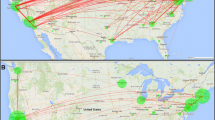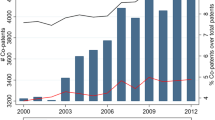Abstract
Scientific research activities cluster in cities or towns. Modern cities can play a crucial role in the national or regional innovation system. Strengthening R&D collaboration between cities can contribute to perfectly integrating various regional innovation systems. Using the cross-sectional co-patent data of the Chinese Patent Database as a proxy for R&D collaboration, this paper investigates the spatial patterns of R&D collaborations between 224 Chinese cities and the major factors that affect cross-city R&D collaborations in China. A spatial interaction model was used to examine how spatial, economic, technological and political factors affect cross-city R&D collaborations. The degree of centrality shows that cross-city collaborative R&D activities mainly occur in favored regions, advanced municipalities and coastal regions. The mean collaboration intensity for intra-provincial cross-city collaborations is 4.74; however, for inter-provincial collaborations, it is 0.69. The econometric findings reveal that spatial, economic, technological and political bias factors do yield significant influences on the frequency of cross-city R&D collaboration. Specifically, as evidenced by the model coefficient, it is more likely that R&D collaborations occur among cities that are connected by high-speed railways.



Similar content being viewed by others
References
Acosta, M., Coronado, D., Ferrándiz, E., & León, M. D. (2010). Factors affecting inter-regional academic scientific collaboration within Europe: The role of economic distance. Scientometrics, 87(1), 63–74.
Breschi, S., & Lissoni, F. (2001). Knowledge spillovers and local innovation systems: A critical survey. Industrial and Corporate Change, 10, 975–1005.
Chen, K., & Kenney, M. (2007). Universities/research institutes and regional innovation systems: The cases of Beijing and Shenzhen. World Development, 35(6), 1056–1074.
Chen, C. T., & Wang, T. (2003). The influence to the local S&T legislation from the view of CAST operation mode forum on science and technology in China. Forum on Science Technology in China, 4, 3–6. (in Chinese).
Fischer, M. M., Scherngell, T., & Jansenberger, E. (2006). The geography of knowledge spillovers between high-technology firms in Europe: Evidence from a spatial interaction modeling perspective. Geographical Analysis, 38(3), 288–309.
Florida, R. (2002). The rise of the creative class: And how it’s transforming work, leisure, community and every day life. New York: Basic Books.
Gao, X., Guan, J., & Rousseau, R. (2011). Mapping collaborative knowledge production in China using patent co-inventorships. Scientometrics, 88(2), 343–362.
Hennemann, S., Wang, T., & Liefner, I. (2011). Measuring regional science networks in China: A comparison of international and domestic bibliographic data sources. Scientometrics, 88(2), 535–554.
Hilbe, J. M. (2011). Negative binomial regression (2nd ed.). Cambridge: Cambridge University Press.
Hoekman, J., Frenken, K., & van Oort, F. (2009). The geography of collaborative knowledge production in Europe. The Annals of Regional Science, 43(3), 721–738.
Hong, W. (2008). Decline of the center: The decentralizing process of knowledge transfer of Chinese universities from 1985 to 2004. Research Policy, 37(4), 580–595.
Hu, Y. J., Scherngell, T., & Liang, C. Y. (2009). The empirical study on inter-regional R&D collaboration in China. Science Technology Management Research, 9, 49–50. (in Chinese).
Jaffe, A. B., Trajtenberg, M., & Henderson, R. (1993). Geographic localization of knowledge spillovers as evidenced by patent citations. The Quarterly Journal of Economics, 108(3), 577–598.
Jonkers, K. (2010). Mobility, migration and the Chinese scientific research system. London: Routledge Press.
Katz, J. (1994). Geographical proximity and scientific collaboration. Scientometrics, 31(1), 31–43.
Leasage, J., Fischer, M. M., & Scherngell, T. (2007). Knowledge spillovers across Europe. Evidence from a Poisson spatial interaction model with spatial effects. Papers in Regional Science, 86, 393–421.
Liang, L., & Zhu, L. (2002). Major factors affecting China’s inter-regional research collaboration: Regional scientific productivity and geographical proximity. Scientometrics, 55(2), 287–316.
Liefner, I., & Hennemann, S. (2011). Structural holes and new dimensions of distance: The spatial configuration of the scientific knowledge network of China’s optical technology sector. Environment and Planning-Part A, 43(4), 810.
Liu, N., & Jia, Y. (2008). Regional policy, regional openness and regional disparity in economic development. Contemporary Economy & Management, 10, 019. (in Chinese).
Long, J. S., & Freese, J. (2001). Regression models for categorical dependent variables using stata. Texas: Stata Press.
Ma, H., Fang, C., Pang, B., & Li, G. (2014). The effect of geographical proximity on scientific cooperation among Chinese cities from 1990 to 2010. PLoS ONE, 9, e111705.
Pan, R. K., Kaski, K., & Fortunato, S. (2012). World citation and collaboration networks: uncovering the role of geography in science. Scientific Reports, 2, 902.
Ponds, R., Van Oort, F., & Frenken, K. (2007). The geographical and institutional proximity of research collaboration. Papers in Regional Science, 86(3), 423–443.
Sassen, S. (1991). The global city: New York, London, Tokyo. Princeton: Princeton University Press.
Scherngell, T., & Barber, M. J. (2011). Distinct spatial characteristics of industrial and public research collaborations: Evidence from the fifth EU Framework Programme. The Annals of Regional Science, 46(2), 247–266.
Scherngell, T., & Hu, Y. (2011). Collaborative knowledge production in China: Regional evidence from a gravity model approach. Regional Studies, 45(6), 755–772.
Schott, T. (1998). Ties between center and periphery in the scientific world-system: Accumulation of rewards, dominance and self-reliance in the center. Journal of World Systems Research, 4(2), 112–144.
Schubert, T., & Sooryamoorthy, R. (2009). Can the centre–periphery model explain patterns of international scientific collaboration among threshold and industrialised countries? The case of South Africa and Germany. Scientometrics, 83(1), 181–203.
Tu, C. L., & Yi, W. H. (2008). Factors and regional disparity of self-innovation capabilities in China. Science Technology Management Research, 1, 39–42. (in Chinese).
Wang, Y., Wu, Y., Pan, Y., Ma, Z., & Rousseau, R. (2005). Scientific collaboration in China as reflected in co-authorship. Scientometrics, 62(2), 183–198.
Xu, J. H., Lu, F., Su, F. L., & Lu, Y. (2005). Spatial and temporal scale analysis on the regional economic disparities in China. Geographical Research, 24(1), 57–68. (in Chinese).
Yoon, J. (2011). Exploring regional innovation capacities of PR China: Toward the study of knowledge divide. PhD thesis, Georgia Institute of Technology.
Zhang, G. C. (2003). Study on the environment of science and technology innovation. Railway Technology Innovation, 2, 7–10. (in Chinese).
Zhang, X., & Kanbur, R. (2005). Spatial inequality in education and health care in China. China Economic Review, 16(2), 189–204.
Zheng, S., & Kahn, M. E. (2013). China’s bullet trains facilitate market integration and mitigate the cost of megacity growth. Proceedings of the National Academy of Sciences, 110(14), E1248–E1253.
Acknowledgements
This work was funded by the research projects of the Philosophy and Social Science Foundation of Nanjing Medical University (Project No. 2013NJZS10) and the Scholarship of Jiangsu Province Government Sponsorship for Overseas Study. The authors would thank anonymous reviewers for their valuable comments.
Author contributions
All authors designed and performed the research. Sheng-qiang Jiang and Xin Li collected the data and participated in the writing of the manuscript. Zhi-hang Peng, Xin Li and An-na Shi contributed to data analysis.
Author information
Authors and Affiliations
Corresponding authors
Ethics declarations
Conflict of interest
Competing financial interests: The authors declared no competing financial interests.
Electronic supplementary material
Below is the link to the electronic supplementary material.
Rights and permissions
About this article
Cite this article
Jiang, Sq., Shi, An., Peng, Zh. et al. Major factors affecting cross-city R&D collaborations in China: evidence from cross-sectional co-patent data between 224 cities. Scientometrics 111, 1251–1266 (2017). https://doi.org/10.1007/s11192-017-2358-2
Received:
Published:
Issue Date:
DOI: https://doi.org/10.1007/s11192-017-2358-2




